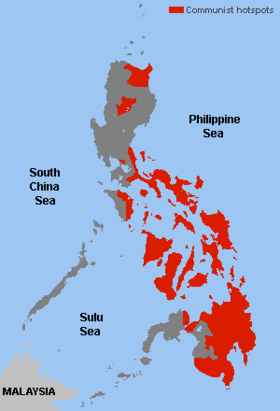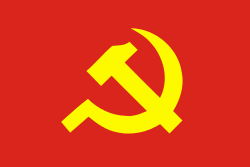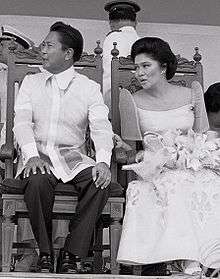CPP–NPA–NDF rebellion
| ||||||||||||||||||||||||||||||||
The CPP–NPA–NDF rebellion refers to conflict between the government of the Philippines, the Communist Party of the Philippines (CPP), the New People's Army (NPA) and the National Democratic Front (NDF).
In 1969, NPA was formed, and the first violent incident took place in 1971. A year later, President Ferdinand Marcos introduced martial law. Until 2002, NPA received a considerable amount of aid from outside the Philippines. However, later developments forced it to rely on support from other local sources. Between 1969 and 2008, more than 43,000 insurgency related fatalities were recorded.[9]
Background
The NPA broke off from the Communist Party of the Philippines (CPP) on 29 March 1969.[10][5] Previously, NPA served as the military wing of the CPP but left the Party due to its perceived ineffectiveness. Under the leadership of Bernabe Buscayno, the NPA dropped the traditional Marxist-Leninist ideologies of the CPP in favor of Marxist-Leninist-Maoist principles, aimed at creating a national democratic state through rural guerrilla warfare. The initial strength of the NPA was believed to comprise approximately 60 guerrillas and 35 weapons. NPA went on to proclaim itself the successor to Hukbalahap, a communist insurgent faction that fought against the Japanese occupation of the Philippines during World War II, as well as the Philippine government in the rebellion (1942-1954).[9]
Insurgency
On 21 August 1971, the first act of NPA rebellion took place when NPA militants threw two grenades onto the stage at a Liberal Party rally in Manila, killing 9 people and injuring 95 others. Relying on small armed community-based propaganda units, the NPA found itself in an all-out rebellion by 1972.[10] On 21 September 1972, president Ferdinand Marcos declared Martial Law, which forced the NPA to fight for its freedom. In 1974, the NPA launched its first tactical operation in Calbiga, Samar, when it ambushed an army scout patrol and seized a number of their weapons.[9]
China provided support to the NPA from 1969-1976. After that period, the Chinese ceased all aid, resulting in a five-year period of reduced activity. Despite the setback, the rebellion rekindled with funds from revolutionary taxes, extortion and large scale foreign support campaigns.[10] Both the CPP and NPA attempted to garner support from the Workers Party of Korea, the Maoist factions of the Palestinian Liberation Organization, Japanese Red Army, Sandinista National Liberation Front, Communist Party of El Salvador, Peruvian Communist Party, and the Algerian military. Financial aid, training and other forms of support were received from a number of the above. NDF controlled trading companies were allegedly set up in Hong Kong, Belgium, and Yugoslavia. At the same time the Communist Party of the Philippines formed a unit in the Netherlands and sent representatives to Germany, France, Italy, Greece, Ireland, United States, Sweden, and various parts of the Middle East. Despite the massive amount of aid previously received, foreign support eventually dried up following the 1990s collapse of communist regimes worldwide.[5]
Between the 1970s and 1980s, thousands of volunteers, including youth and teenagers from both urban and rural areas, joined the organization. In 1992, NPA split into two factions: the reaffirmist faction led by Sison and the rejectionist faction which advocated the formation of larger military units and urban insurgencies. Through NPA's history, 13 smaller factions emerged from the group,[11] the most notable being MLPP-RHB, APP, RPA-M, RPM/P-RPA-ABB and CPLA. A parallel Moro insurgency created favorable conditions for the development of NPA. During the 1970s, 75% of the Philippine military was deployed on the island of Mindanao, a Moro stronghold, despite the 1976 peace deal between the government and MILF. As of 2000, 40% of the AFP troops continued to engage Moro rebels.[9]
In 2001, AFP launched a campaign of selective extrajudicial killings, in an attempt to suppress NPA activity. By targeting suspected rebels sympathizers, the campaign aimed to destroy the communist political infrastructure. The program was modeled after the Phoenix Program, a U.S. project implemented during the Vietnam War. According to Dr William Norman Holden, University of Calgary, security forces carried out a total of 1,335 extrajudicial killings between January 2001 – October 2012.[9]
On 9 August 2002, NPA was designated a Foreign Terrorist Organization (FTO) by the United States Department of State. A parallel increase in counter insurgency operations negatively affected the course of the rebellion. Netherlands based Jose Maria Sison is currently leader of CPP's eight member politburo and 26 member central committee—the party's highest ruling bodies. Despite the existence of the politburo, NPA's local units receive a high level of autonomy due to difficulties in communication between each of the fronts across the country.[5]
Rebel recruits receive combat training from veteran fighters and ideological training by Mao Zedong in: the Three Main Rules of Discipline and Eight Points of Attention; the Comprehensive Agreement to Respect Human Rights and International Humanitarian Law. NPA units usually consist of 15–30 fighters, with special armed partisan units of 50–60 rebels serving in a special operations capacity.[12] NPA also formed a limited tactical alliance with the Moro National Liberation Front and the Moro Islamic Liberation Front on the island of Mindanao, enabling the mutual transfer of troops through each other's territory.[5] Between 1969-2008, more than 43,000 insurgency related fatalities were recorded.[9]
Plantations run by Japanese companies have been assaulted by the NPA.[13]
Samar
Since the early stages of the rebellion, the island of Samar has been considered to be NPA's main stronghold. While Samar represents 2% and 5% of the Philippine population and territory respectively, 11% of all NPA related incidents have taken place on the island. Samar's terrain consists of densely forested mountainous areas, providing fertile ground for the conduct of guerrilla warfare.[9]
An important factor in the spread of the rebellion was the issue of widespread landlessness. Land reforms provided only a limited solution for the millions of Philippine landless farmers. In the case of Samar, 40 landowning clans controlled approximately half of the island's agricultural land. Instances of landowner harassment and violence towards working class tenants led to escalating tensions between the two social groups.[9]
In 1976, NPA gained popular support among the inhabitants of Samar following vigilante actions against cattle rustling gangs. The following year, NPA transferred agents from Cebu and Manila where conditions were less favorable. The influx of troops enable NPA to form units fully engaged in guerrilla activities. In 1982, an unofficial communist government was formed, solidifying Samar as a communist stronghold. The 1980s downfall of the coconut industry greatly affected livelihoods of many Samaranos, further fueling the rebellion. Between January 2011 and December 2012, a total of 153 insurgency related incidents took place in Samar, resulting in 21 deaths and 55 injuries.[9]
See also
References
- ↑ "PHL, NDF sign indefinite ceasefire pact". GMA News. August 26, 2016. Retrieved August 26, 2016.
- ↑ "Duterte restores ceasefire with communists rebels". Philippine Daily Inquirer. August 21, 2016. Retrieved August 22, 2016.
- ↑ "Duterte restores ceasefire with communists rebels". GMA News. August 19, 2016. Retrieved August 22, 2016.
- ↑ "GPH, NDF peace panels now in Oslo". Manila Bulletin. August 22, 2016. Retrieved August 22, 2016.
- 1 2 3 4 5 "Communist Party of the Philippines and its New People's Army (CPP-NPA)". ISN ETH. 2010. Retrieved 13 February 2015.
- ↑ "Military Strength". 17 February 2015. Retrieved 23 February 2015.
- ↑ "Philippines' highest-ranking communist rebel held: military". AFP. 2 June 2015. Retrieved 3 June 2015.
- ↑ FERNANDEZ, AMANDA (29 March 2014). "NPA guerrillas mainly concentrated in north-eastern, southern Mindanao — AFP". GMA News. Retrieved 30 March 2014.
- 1 2 3 4 5 6 7 8 9 "The Never Ending War in the Wounded Land: The New People's Army on Samar". University of Calgary. 12 November 2013. Retrieved 14 February 2015.
- 1 2 3 "New People's Army". Stanford University. 22 August 2012. Retrieved 9 February 2015.
- ↑ "Philippines-CPP/NPA (1969 – first combat deaths)". August 2014. Retrieved 23 February 2015.
- ↑ "NPA – TRENDS IN RECENT ATTACKS". Wikileaks. 10 August 2006. Retrieved 15 February 2015.
- ↑ http://www.manilatimes.net/rebels-own-up-raid-on-japanese-fruit-exporter-in-mindanao/70246/ http://www.philippinerevolution.net/statements/20121204_npa-thwarts-fascist-army-brigade-wide-clearing-operation-for-japanese-banana-firm-in-magpet http://www.philippinerevolution.net/statements/20121204_npa-thwarts-fascist-army-brigade-wide-clearing-operation-for-japanese-banana-firm-in-magpet http://www.andnowuknow.com/headlines/rebel-forces-philippines-raid-sumitomo-fruits-japanese-fruit-exporter/jordan-okumura http://earthfirstjournal.org/newswire/2014/03/12/npa-rebels-own-up-deadly-attacks-in-philippines-vow-to-strike-at-plantations-mining-firms/ http://www.freshfruitportal.com/news/2014/08/24/communist-rebels-attack-two-philippine-banana-plantations/ http://www.forbes.com/sites/forbesasia/2015/08/26/king-of-ore-despite-nickel-asias-raids-zamora-did-not-retreat/#556ef9491c29 http://www.liveleak.com/view?i=7e2_1403613988 http://www.liveleak.com/view?i=6cf_1403841858 http://www.liveleak.com/view?i=6cf_1403841858#cVJRt3w6e0Tye17i.99 https://www.youtube.com/watch?v=UeBDtwmu01k&feature=youtu.be http://www.manilatimes.net/rebels-own-up-raid-on-japanese-fruit-exporter-in-mindanao/70246/ http://davaotoday.com/main/politics/npa-says-bukidnon-plantations-raze-done-to-stop-destructive-expansions/ http://www.philippinerevolution.net/statements/20121204_npa-thwarts-fascist-army-brigade-wide-clearing-operation-for-japanese-banana-firm-in-magpet



